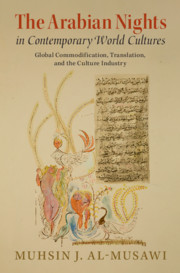 The Arabian Nights in Contemporary World Cultures
The Arabian Nights in Contemporary World Cultures Book contents
- The Arabian Nights in Contemporary World Cultures
- Frontispiece
- The Arabian Nights in Contemporary World Cultures
- Copyright page
- Dedication
- Contents
- Figures
- Acknowledgments
- Introduction
- 1 The Arabian Nights
- 2 The Scheherazade Factor
- 3 Engagements in Narrative
- 4 The “Hostile Dynasty”
- 5 The Archaeology of A Thousand and One Nights
- 6 Signatures and Affiliates
- 7 Decolonizing the Arabian Nights?
- 8 Invitation to Discourse
- Book part
- Select Bibliography
- Index
8 - Invitation to Discourse
Published online by Cambridge University Press: 17 August 2021
- The Arabian Nights in Contemporary World Cultures
- Frontispiece
- The Arabian Nights in Contemporary World Cultures
- Copyright page
- Dedication
- Contents
- Figures
- Acknowledgments
- Introduction
- 1 The Arabian Nights
- 2 The Scheherazade Factor
- 3 Engagements in Narrative
- 4 The “Hostile Dynasty”
- 5 The Archaeology of A Thousand and One Nights
- 6 Signatures and Affiliates
- 7 Decolonizing the Arabian Nights?
- 8 Invitation to Discourse
- Book part
- Select Bibliography
- Index
Summary
Chapter 8 wraps up the discussion. It attempts to show how the Nights has been opening the gate for every kind of reading. Although the book, and this chapter in particular, is not a survey of scholarship, it selects instances that show a genealogical string that brings all the players on board, showing how the often marginalized John Payne is pivotal to the twentieth-century scene, not only because he was Richard F. Burton’s ghost translator, but also because he set the road for literary classification of the tales that nobody, not even Burton, can overlook. Twentieth-century scholars like Mia Gerhardt or Peter Heath cannot devise more typologies than Payne’s, but they add what “conditions of possibility” allow. The chapter focuses on critical typologies, textual and genealogical criticism, the comparatists’ pursuits, and also literary criticism. The latter covers genres and translational mediums, and poetics of narrative. It also looks upon cultural criticism as more nuanced than nineteenth-century readings of manners and customs. The chapter has to conclude with the question: Is the Nights adab? A refined belles lettres?
- Type
- Chapter
- Information
- The Arabian Nights in Contemporary World CulturesGlobal Commodification, Translation, and the Culture Industry, pp. 281 - 325Publisher: Cambridge University PressPrint publication year: 2021
